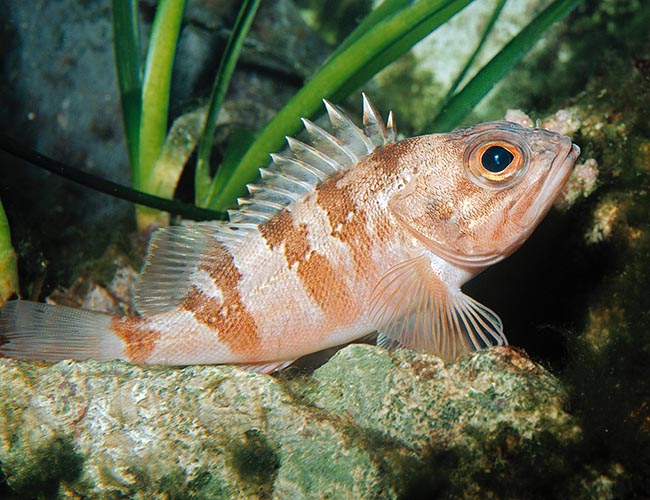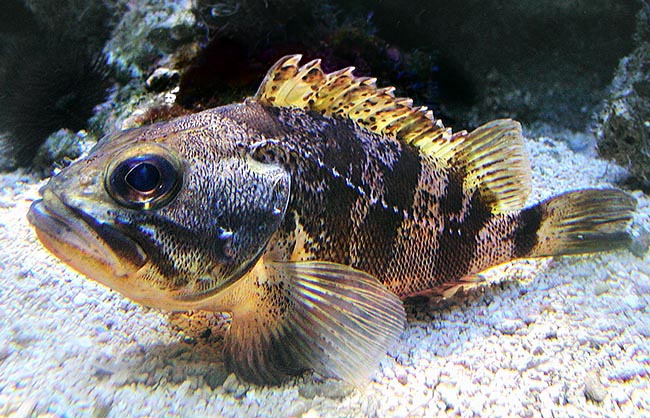Family : Sebastidae

Text © Giuseppe Mazza

English translation by Mario Beltramini

Blackbelly rosefish (Helicolenus dactylopterus) reaches the 1.100 m of depth © Giuseppe Mazza
It is assumed that the name of the genus comes from the Greek “helikos” = spiral and “lenos” = cavity, with reference to the huge pectoral fins, which the fish spins spirally in order to walk over the sea bottom and are hollow for a half, that is, not having the membrane usually existing between the rays. The name of the species comes from the Greek “dactyl” = fingers and “pteron” = wing, the same etymology and meaning of the known genus Dactylopterus.
Zoogeography
Besides the Mediterranean, the blackbelly rosefish has a very vast distribution. In fact, it colonizes the two Atlantic coasts, from Canada to Venezuela and from Iceland to South Africa, including the Azores, the Cary, Madeira and Cape Verde Islands.
Ecology-Habitat
It is at home at enormous depths on sandy and compact bottoms of the continental shelf, from 50 to 1.100 m, but, at times, it comes up and one blackbelly rosefish has been found in only 20 m of water.
Morpho-physiology
It reaches the 47 cm, but the fished specimens usually measure 25-30 cm. The ehad is stocky, covered by spines over the eyes, on the operculum and the pre-operculum. The mouth, huge, has a monstrous opening almost reaching the eye. Inside stand 4-5 rows of needle-like teeth on the jaw and 3-4 on the mandible, not to talk about those of the vomer and of the palatine ones. The eye, enormous, is perfectly suitable for the great depths.

An old specimen with darker tints. Pattern keeps unchanged © Giuseppe Mazza
The dominant colour is the reddish-brown. On the pink sides stand out some typical dark bands. The belly is white and the mouth, inside, is black-bluish.
Like other scorpionfishes, the spines are connected to venom glands and the stings are much painful.
Ethology-Reproductive Biology
The blackbelly rosefish is a predator. It nourishes, greedily, of fishes, cephalopods, crustaceans and echinoderms.
The fecundation is internal. The matings take place even before, but the development of the oöcytes begins in December inside the body of the mother. The larvae, already partially developed, are laid on the bottom, protected by a gelatinous mass. When this dissolves, they become planktonic.
The blackbelly rosefish is caught in big quantities with the trawl nets. If able to escape the dangers, its lifespan is of 43 years. The vulnerability index of this species is of 53 over 100.
Synonyms
Helicolenus imperialis Cuvier, 1829; Helicolenus maculatus Cuvier, 1829; Helicolenus maderensis Goode & Bean, 1896; Helicolenus thelmae Fowler, 1937; Scorpaena dactyloptera Delaroche, 1809; Sebastes dactylopterus Delaroche, 1809; Sebastes imperialis Cuvier, 1829; Sebastes maculatus Cuvier, 1829.
→ For general information about FISH please click here.
→ For general information about BONY FISH please click here
→ For general information about CARTILAGINOUS FISH please click here.
→ To appreciate the BIODIVERSITY of BONY FISH please click here.
→ To appreciate the BIODIVERSITY of CARTILAGINOUS FISH please click here.
